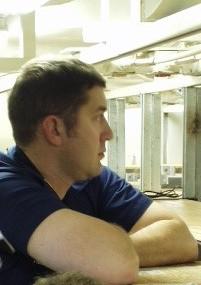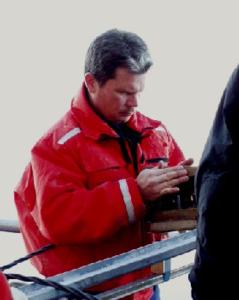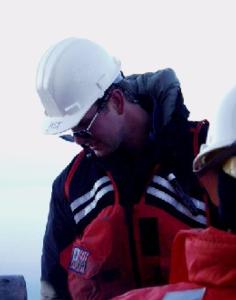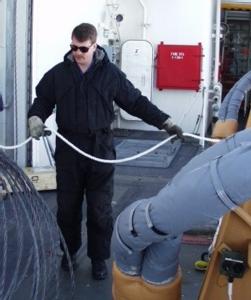
|
|
19 June, 2000
19 June 2000
MSTs - Marine Science Techs
Everyone on board USCGC Healy is necessary for the day-to-day operation
that makes the vessel available for use as a floating laboratory as
discussed in yesterday’s entry. However, there is a group whose primary
focus is helping the science get done on the ship. These are the MSTs, or
Marine Science Techs, but you could almost change the letters to MSP -
Making Science Possible.
There are four MSTs stationed on the HEALY and one temporarily attached
during the science-testing phase. The four stationed on the ship are MSTC
Glen Hendrickson and working for him are MST1 David Hutchinson, MST2 El
McFadden, and MST2 John Albrough. The officer in charge of this group is
LTJG Todd Adrian (see 06/10 - Diving In) who is the designated Marine
Science Officer.
According to Chief Hendrickson, the role of MSTs in the Coast Guard is
primarily marine safety. The vast majority of MSTs are land-based and
monitor pollutants, inspect vessels to make sure they meet Coast Guard
standards, insure compliance with U.S. environmental law, support science
operations, and supply weather information. Shipboard MSTs are only found
on USCG icebreakers and the USCGC Healy is the newest in a long line of USCG
icebreaker tradition. On this ship, the science support makes up the
majority of the work that our MSTs do each day.
I’d like to use part of this journal to introduce you to the people that
assist with the science that is taking place on board this ship. Chief
Hendrickson joined the Coast Guard after eight years in the U.S. Air Force.
He learned many languages as a linguist in the Air Force and is fluent in
Spanish and Vietnamese. He has served 14 years in the Coast Guard where he
now slings the lingo of science and keeps his many other languages available
for ports of call. He is impressed with the scientific capabilities of the
HEALY which put it on a level with the AGOR class vessels like University of
Washington’s RV Thomas Thompson and Scripps’s RV Roger Revelle. The
advantage the HEALY has over those vessels is its icebreaking capabilities.
Pleased with the tests so far, Chief Hendrickson acknowledges that there are
some bugs to be worked out, as there would be on any new vessel. The chief
is eagerly looking forward to the first real science mission early in 2001.
MST1 David Hutchinson, better known as “Hutch”, is an 18-year veteran of
the Coast Guard and 17 of those years have been as an MST. “I’ve found my
niche”, says Hutch. He has been in the arctic every summer since 1984 with
one exception, and he has spent five summers (our winter) in the Antarctic.
His polar work is by choice; he doesn’t care for the heat. The HEALY is a
great post, too. According to Hutch, the HEALY is “a great science boat,
more toys for an MST to play with than any other ship”. Born in Washington,
DC and raised in Linthicum, MD, MST1 Hutchinson has found a wonderful
opportunity to travel with the Coast Guard. His work has taken him to 35
different countries with Scoresby Sound, Greenland and the Antarctic
Peninsula taking the tops in scenery. Joining the Coast Guard right out of
college, Hutch has made a life long career out of doing science.
MST1 Eldridge C. McFadden II (aka El) has been in the Coast Guard for 8
years and the USCGC Healy was his dream posting. Actually, Coast Guard was
an interest of El’s when he got out of high school, but the recruiter was
out of town and hadn’t returned his call. El ended up with the service that
had a local recruiter - the army. After four years in U.S. Army
communications, including time in Desert Storm, El was ready to try for the
Coast Guard again. After a complicated series of attempts trying to get
into the Coast Guard, El was finally able to get in. While waiting to get
in, El found an interest in marine science during a college class that took
him to San Pedro for some ship time and introduced him to dredging. He and
his wife wanted the to be on the west coast and they lucked out when El
received the only opening available on the shores of the Pacific - a buoy
tender in San Francisco. MST school in Yorktown, Virginia led them to
another west coast posting in Portland, Oregon, where El was involved in
marine safety and environmental issues. While working in Portland, El
turned in his dream list and the HEALY was #1. Two years later he got the
call and he’s been with the ship since. El puts in a lot of time on the
computers, but also enjoys the deck work with scientific gear. He
especially likes working with weather observations and forecasting. His
sons Alex (7) and Jasper (4), and his wife of 11 years Daina look forward to
his return to their home in Bremerton, Washington.
MST2 John Albrough has not had an MST job on a ship other than the USCGC
Healy. His family had a history of service with the Coast Guard and John
saw it as an opportunity to get out of the small town of Brimley, Michigan
where he grew up. Brimley is so close to the Canadian border that John was
actually born in a Canadian hospital and has dual citizenship. John went to
MST school after service as a seaman on a buoy tender, interestingly enough,
the same tender El was on, just before him. He chose MST school because he
liked the opportunity it presented to make a difference in the world. Upon
graduation, John was chosen for service on the HEALY, a position that he
felt offered him an excellent opportunity for travel (something many MSTs
seldom get to do). His time with the ship will end in Dublin, Ireland when
he heads to Novato, California to join the Coast Guard’s Pacific Strike
Team. Their role of dealing with oil spills, chemical releases, and working
with the EPA regarding environmental protection is more along the lines of
why John became an MST in the first place. MST2 Albrough was proud of his
selection to the HEALY and pointed out that out of the 495 MSTs in the USCG,
only 10-12 are working on either of the three research vessels (HEALY, Polar
Sea, or Polar Star) at any one time. He feels the experience he gains on
USCGC Healy and as a member of the Pacific Strike Team will give him
excellent experience and skills to go on to complete college and future
employment outside the service. John’s auxiliary duties on the HEALY
include Hazardous Materials Coordinator and Partnership in Education
Coordinator.
Each of these individuals makes a significant contribution to the scientific
work done onboard the HEALY. Their roles will become increasingly important
in the future as researchers come on board to collect their data and want
data from other equipment. That is when their experiences on this test
cruise will really pay off. When a scientist collecting coring data also
wants CTD information, the MSTs will be able to provide it for them; they
will make that science possible.

John listens to the briefing in the science room that outlines what will be done during the coring operation.

Chief Glen Hendrickson at work on the piston core.

El McFadden preparing the end of the core for deployment.

Hutch working on the lines needed to assemble and deploy the core.
Contact the TEA in the field at
.
If you cannot connect through your browser, copy the
TEA's e-mail address in the "To:" line of
your favorite e-mail package.
|
